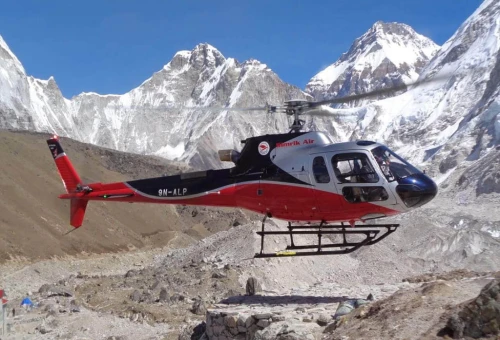Trek Everest and Khumbu region
The spectacular Everest base camp trek with a glimpse of the world's highest Mt. Everest
Everest region, also called Khumbu region, offers a glimpse of the lifestyle and culture of the world-renowned mountain race Sherpas. In addition to experiencing the Buddhist Sherpa culture, you can get a proximate view of Everest (8848m) and other mountains of the Khumbu range. The word ‘Khumbu’ means mountains in Sherpa language. Indeed, trekkers will be trekking parallel to the mountain ranges from proximity throughout the Everest trek.
From the vantage point of 'Pike Peak', trekkers can observe a breathtaking view of several mountains like Lhotse (8511m), Nuptse (7864m), Cho-Oyu (8201m), Makalu (8475m), among others. From this viewpoint, you can also get a bird's eye view of the Sherpa towns, and a trail of trekkers ascending towards their destination of Everest Camp Base, Khumjung, or Thame.
Virtually all Holiday planners and tourism surveyors have described the Everest region as one of the world's best travel destinations.
High Light: Namche Bazar- the capital of Sherpas, The rich Sherpa culture, excellent lodge, and the immense view of Mount Everest with the ice fall from the Kalapathar (5545m.) and the everyday view of the prestigious summits: Amadablam (6856m), Thamserku (6608m), Pumori (7145m) and Nuptse (7879m) and Gokyo icy Lake

Physical Condition & practical Requirements:
Walking in the Himalayas or highlands requires a normal level of physical fitness or 6 - 7 hours of walking per day. Unlike on ascending peaks, trekkers do not have to go through any technical difficulties. The walking duration is planned so the trekkers have enough time to explore the region and its people without physical exertion.
Our itineraries are categorized according to the difficulty level and the duration of the day. The schedules are given for information only but are subject to change the journey slightly from one year to another, especially depending on the finding of fresh water on spots for the camp trek and any circumstances.
People and ethnic groups of Everest base camp trek and the Khumbu valley
The Everest region is inhabited by the renowned high mountain people of Sherpa, who are believed to have migrated from eastern Tibet some four centuries ago. The Sherpas are more closely related to Tibet than many of their southern neighbors and practice Buddhism. Today some of the small population of other ethnic groups like RAI, and TAMANG from the neighboring highland are settled, and Brahmin, Chhetris, and Newar from further afield.
The climate of Everest base camp trek and Khumbu valley
The monsoon is almost everywhere in Nepal from mid-June to the end of September.
The most popular season is autumn (October-November) when the rains wash the skies and the weather views are superior, the spring (March-May) season is another popular season for trekkers, the hillsides are covered with blooming rhododendrons from 1500m to 3000m altitude with different varieties of rhododendrons. Similarly, most people are not keen to trek in the winter when the temperature is too cold for comfort at high elevations and snow can block high passes.
Access to the Everest base camp trek
Most people usually opt for scenic flights from Kathmandu to Lukla (2800m). During the high season and because of occasional poor weather, flights can be delayed causing a bottleneck and limiting the flow of tourists in and out of the region.
Another option is to drive a long and narrow road drive about 200km to Jiri and then follow the historical footsteps of Edmund Hillary and Tenzing Norgay Sherpa, the legend of the Everest expedition which had done in May 1953. The hike adds another week to the journey but will help the acclimatization process and get the legs and lungs in shape, too. The trek from Jiri has enough ups (and downs) to reach Everest base camp.
Temperatures of Everest base camp trek and Khumbu valley
The temperature range depends primarily on the season. Under normal conditions, the rate of temperature drop as altitude is added is generally 6.4ºC per 1000 feet (3.5ºF/1000fit). The landscape will affect temperature including the direction of the slope face (north-facing slopes receive less sunlight and therefore are generally cooler, the amount of cover by plants that provide shade, and the presence of rivers and bodies of water also have a cooling effect. However, in terms of temperatures from 1200m to 2500m, the month of October / November is generally beautiful and sunny. It is mild to cool in the valleys during the night (minimum 12 / 15ºC) and the day (maximum 25 / 26º). Above 3000m, the temperatures will be decreased. At 5000m, they range between -10º (night) and 12 / 13º (daytime).
The Spring season, during March/April at 1200m to 2500m, is mostly dry, mild to hot, and dusty, the hillsides are covered with blooming rhododendrons in Annapurna, Manaslu, Dhaulagiri, and Langtang trekking regions. The sky is clear in the morning and generally windy with occasional thundershowers in the afternoons. The temperature is about (minimum 15/20ºC) during the night and (maximum 28 / 32º) during the daytime. Above 3000m, the temperatures will be decreased. At 5000m, they range between -5º (night) and 15/ 16º (daytime).
Winter, December to February the temperature is dry with occasional showers, cold, freezing in high altitudes, and snow risk at high passes.






-(1200-x-630-px)-(572-x-385-px)-(500-x-340-px).webp)

.webp)